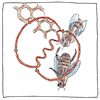Karl von Frisch
entomology

|
Dancing bees
On a honeybee’s sense of smell, its color vision its sensitivity to ultraviolet, its sense of light polarization, its internal clock, its sensitivity to odors, including pheromones, its ability to sense the earth’s magnetic field and its sense of gravity On a honeybee’s ability to dance, to circle, to waggle its abdomen, in the precise direction, for the precise duration and the right number of times Lets it communicate with its mates what food source to find and where and on this depends the health of the hive as Karl von Frisch was able to show with carefully controlled experiments.
Dialects
Von Frisch studied Apis Mellifera Carnica, also known as the Carniolan bee, which speaks Slovenian. The language of the bee varies greatly between varieties. Could we say Apis mellifera ligustica speaks Italian? Apis mellifera mellifera speaks German? Apis mellifera iberiensis speaks Spanish? Apis mellifera cecropia speaks Greek? Apis cerana nuluensis speaks Bornean? Apis cerana indica speaks Burmese? Apis cerana cerana speaks Vietnamese? What Bible student would have thought that bees were also banned from the Tower of Babel?
Language
If bees could talk, then would they tell of their strange world, or would they think every thing that lives can dance, know, without thinking, the direction of the sun, and feel the electric fields of their excitement? If you would listen then I would tell you something that you didn’t know, using words that might seem familiar, but the dear thoughts of other creatures, if we can call them thinkers, are spoken in an unexpected tongue.



Honey bees can see in colors in the ultraviolet, so they get more visual information from flower petals than we get. Bees in the hive can tell by the smell what kind of flower another bee has visited. Bees know their directions by the position of the sun, by the polarization of sunlight, and by the earth’s magnetic field. Given directions in a dark hive to a food source relative to the sun, a bee knows the direction even hours later, compensating for the change in the sun’s position.
See also in The book of science:
Readings in wikipedia: